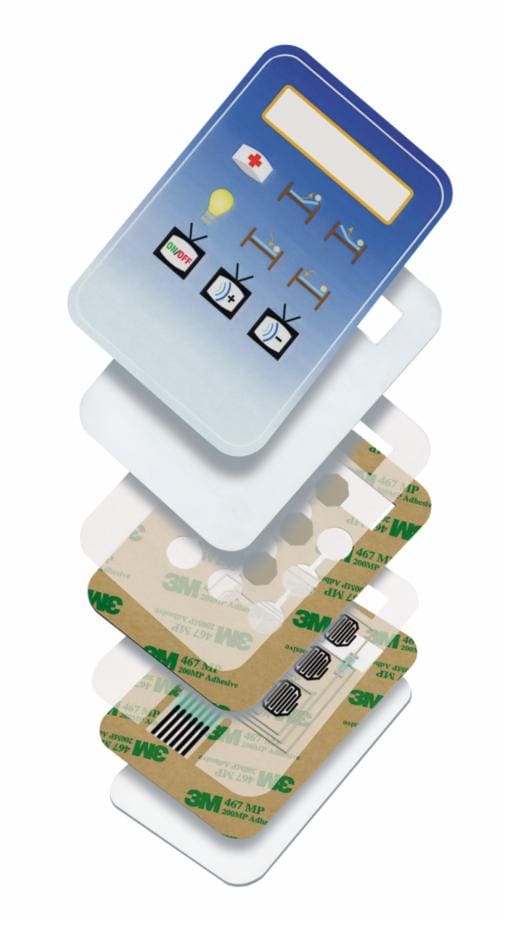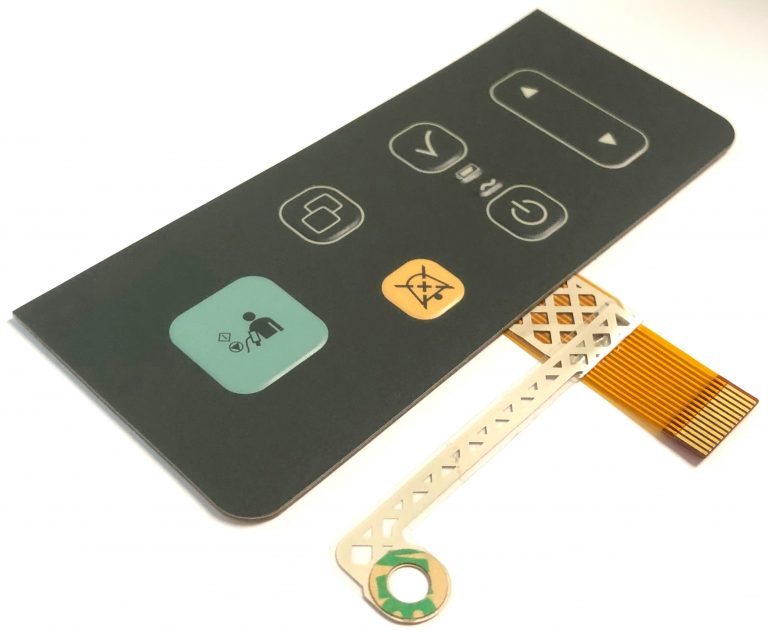Everything About Membrane Switch Over: A Comprehensive Overview for Beginners
Membrane buttons are necessary elements in modern electronics, offering an one-of-a-kind interface for customer interaction - membrane switch. Their split building, including overlays and conductive traces, supplies functionality and durability. Unlike standard mechanical switches, membrane layer switches provide a sleek style and adjustable options. Comprehending their crucial features and benefits can change product design. However, the ins and outs of their application and design factors to consider call for additional expedition
What Is a Membrane layer Switch?
A membrane button is a sort of electric button that contains an adaptable membrane layer layered over a published circuit board. This design enables for a compact and smooth user interface, usually made use of in different digital tools. Membrane layer buttons are typically discovered in customer devices, clinical devices, and industrial equipment as a result of their durability and resistance to environmental factors.The building and construction typically includes multiple layers, such as graphic overlays and glue backing, which offer tactile comments and secure the circuitry beneath. The procedure of a membrane layer button is initiated when pressure is related to the surface, completing an electrical circuit.These buttons are valued for their flexibility, allowing custom styles and published graphics that deal with certain interface. Their low-profile nature lowers room needs, making them excellent for applications where typical buttons might not fit. On the whole, membrane layer switches provide a aesthetic and useful remedy for modern electronic devices.
Trick Elements of Membrane Changes
Membrane layer switches over make up a number of crucial parts that add to their performance and performance. The leading layer, referred to as the overlay, supplies the interface and is typically printed with graphics or icons. Beneath the overlay exists a spacer layer, which separates the conductive elements and avoids unintentional activation. The following crucial component is the visuals layer, which boosts looks and ensures the durability of the design.Conductive traces, commonly made from materials like silver or carbon, are published on the circuit layer. When stress is applied to the overlay, these traces enter into get in touch with, finishing the circuit. In addition, a backing layer supplies structural assistance and can be made from products such as polyester or polycarbonate. With each other, these components produce a dependable, straightforward user interface appropriate for various applications, from family appliances to industrial equipment. Recognizing these elements is essential for any person thinking about membrane layer switch innovation.
Exactly How Membrane Layer Switches Work
Recognizing how membrane layer changes function is necessary for appreciating their prevalent use in different gadgets. A membrane layer button runs via a series of layers, including a graphic overlay, spacer, and a circuit layer. When stress is put on the overlay, it compresses the spacer layer, permitting the circuit layer to make contact and complete an electrical circuit. This activity sends out a signal to the tool, triggering a reaction, such as switching on a light or turning on a function.Membrane switches over can be designed with various functions, consisting of responsive responses, backlighting, and custom graphics, improving individual interaction. Their building permits a closed design, safeguarding the interior elements from dirt, moisture, and pollutants. This toughness makes them ideal for varied applications, from customer electronic devices to commercial tools. Overall, the simplicity and performance of membrane changes contribute to their popularity in modern technology.
Advantages of Membrane Switches Over Mechanical Switches
While mechanical buttons have actually long been a staple in several tools, membrane layer changes deal unique advantages that make them increasingly appealing. One substantial benefit is their slim profile, permitting more small layouts and higher versatility in product growth. Additionally, membrane switches over function an uniform surface area, which boosts visual charm and simplifies cleansing, making them ideal for environments where health is critical.Another advantage is their resistance to dust and dampness. Unlike mechanical buttons, which can be endangered by environmental factors, membrane layer switches provide a sealed user interface that protects against impurities - membrane switch. Membrane switches typically have a longer life-span due to fewer moving components, resulting in boosted longevity and reliability.Cost-effectiveness is likewise a remarkable benefit, as membrane layer buttons can be produced in mass with reduced production expenses. These variables combine to place membrane layer switches as a practical option to traditional mechanical choices in numerous applications
Typical Applications of Membrane Layer Switches
Membrane buttons are extensively made use of in various industries, particularly in consumer electronic devices and commercial control panels. In consumer gadgets, they give a smooth, straightforward interface, while in industrial settings, they improve durability and performance. Comprehending these applications highlights the convenience and practicality of membrane buttons in modern innovation.
Customer Electronics Gadgets
As customer electronic devices remain to evolve, membrane switches have ended up being a prominent option for a selection of devices due to their flexibility and smooth style. These buttons are generally located see page in smart devices, tablets, and push-button controls, where space is limited and looks issue. Their reduced account and personalized layouts enable makers to produce straightforward user interfaces that improve the general user experience. In addition, membrane switches are frequently used in devices such as microwaves and coffee machine, offering instinctive control options while withstanding dampness and dirt. The longevity and integrity of membrane changes make them ideal this post for daily consumer items, ensuring longevity and consistent performance. Overall, their assimilation in customer electronic devices shows a mix of functionality and contemporary style.
Industrial Control Panels
The applications of membrane layer switches expand beyond customer electronics, discovering considerable usage in commercial control panels. These buttons are preferred for their toughness and resistance to extreme atmospheres, making them optimal for producing and process control settings. They give a reliable user interface for operators to manage machinery, screen procedures, and readjust setups. Membrane switches can be customized to suit details functional demands, including attributes like backlighting and tactile responses, boosting individual experience. Their low-profile layout enables integration into numerous tools, while their capability to hold up against spills, dust, and extreme temperature levels assurances longevity. Overall, membrane buttons add to risk-free and reliable procedure in industrial applications, showing their adaptability and effectiveness popular atmospheres.
Factors To Consider for Creating Membrane Switches Over
When designing membrane switches, choosing the appropriate materials is necessary to assure resilience and functionality. Furthermore, recognizing layer arrangement strategies can greatly affect the button's efficiency and individual experience. These factors to consider play a vital role in producing trusted and effective membrane switch designs.
Material Selection Value
Product choice plays a crucial duty in the design and functionality of membrane buttons. The picked products straight impact the switch's sturdiness, tactile reaction, and total visual. Secret considerations include the substratum, which should offer structural integrity while permitting adaptability, and the graphic overlay, which requires to be immune to wear and environmental variables. Conductive products should ensure reputable electrical performance, while adhesives have to supply strong bonding without compromising the switch's operation. Additionally, compatibility with making procedures and end-user environments is essential; materials need to stand up to varying temperature levels, humidity levels, and chemical direct exposure. Ultimately, appropriate product option not just improves the membrane layer switch's efficiency however likewise adds to its long life and individual satisfaction, making it an important facet of the design process.

Layer Arrangement Techniques

Often Asked Inquiries
How Much Time Do Membrane Layer Changes Typically Last?
Membrane layer buttons normally have a life-span of 1 to 5 million cycles, depending upon use and environmental conditions. Variables such as design high quality and operating regularity significantly influence their toughness and total performance long life.

Can Membrane Layer Switches Be Customized for Certain Designs?
Membrane layer buttons can undoubtedly be tailored to fit particular designs, enabling varied forms, colors, and functionalities. This versatility makes it possible for makers to tailor these buttons to satisfy unique visual and operational requirements efficiently.
What Materials Are Made Use Of in Membrane Switch Over Building?
Membrane layer switches are normally constructed utilizing products such as polyester, polycarbonate, and sticky layers. These materials supply resistance, versatility, and sturdiness to environmental factors, guaranteeing the buttons operate properly in different applications and problems.
Are Membrane Changes Resistant or waterproof to Dampness?
Membrane layer switches can be developed to be moisture-resistant, using specialized materials and layers. However, their water resistant abilities rely on building and construction high quality and details applications, making it necessary to examine needs for suitable efficiency in various atmospheres.
Just How Are Membrane Layer Changes Repaired if Harmed?
Repairing damaged membrane changes normally involves replacing the affected layer or circuit. Specialists might likewise apply conductive adhesive or make use of specialized fixing kits, guaranteeing performance is restored without full substitute of the entire switch setting up. Unlike conventional mechanical buttons, membrane buttons provide a smooth style and customizable options. A membrane layer switch is a type of electric button that consists of a flexible membrane layer layered over a printed circuit board. The procedure of a membrane layer button is started when pressure is used to the surface, finishing an electrical circuit.These buttons are valued for their convenience, allowing custom layouts and printed graphics that cater to specific customer interfaces. While mechanical switches have actually long been a staple in numerous tools, membrane layer switches over offer distinctive advantages that make them significantly appealing. Membrane buttons usually have a longer life expectancy due to less moving components, resulting in enhanced toughness and reliability.Cost-effectiveness is likewise a notable benefit, as membrane layer buttons can be generated in bulk with reduced manufacturing expenses.
Comments on “The benefits of using membrane switch in frequently used applications”